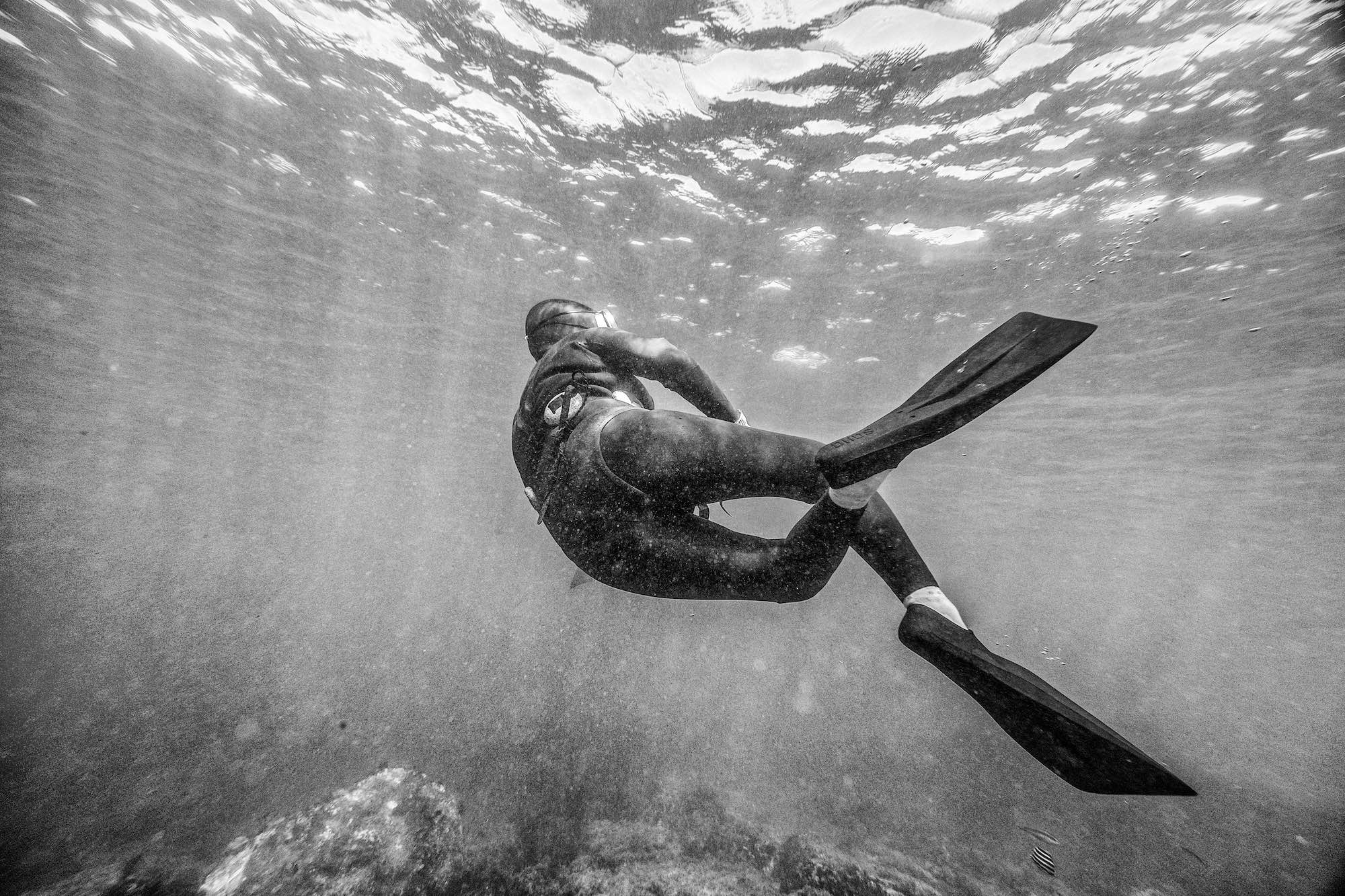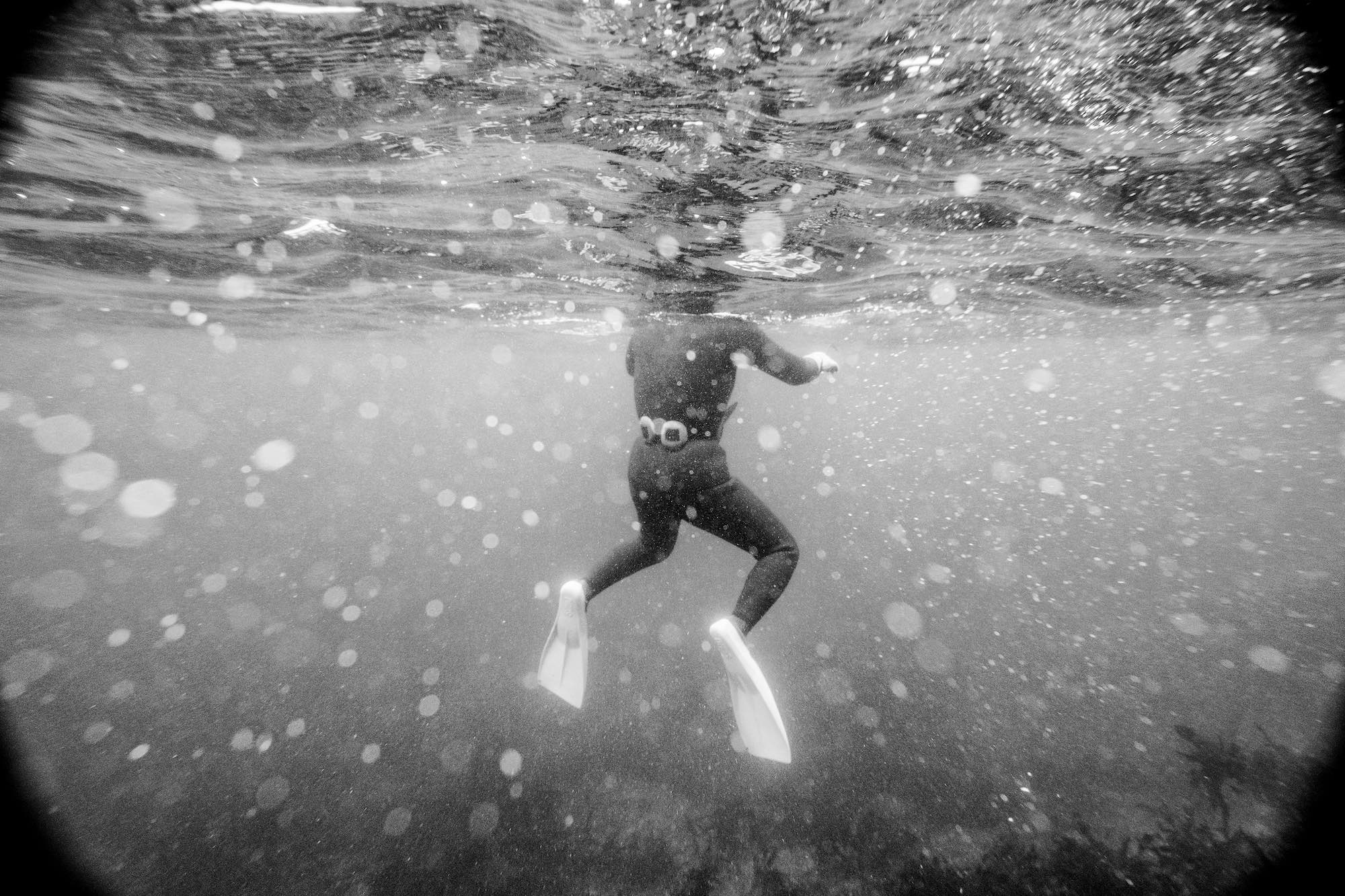This is an extended version of our article in Lens Magazine Issue 93, ‘The Big B&W Issue 2022’

After donning her wet suit, flippers, and goggles, the female diver exits the boat and dives into the frigid waters off the coast of Jeju Island in South Korea. Her grace and agility in the water are a vast difference from her slow, stiff movements back on land. Any sign of her feeling the effects of her 60 over years of age seems to melt away as she dives downwards, propelling her body in short, powerful strokes.
In black and white, I capture her in the water mid-way to the ocean floor, suspended between two worlds.

Black and White Photography Underwater
In general, black and white photography is less commonly used for underwater shots.
After all, colour photography lends itself well to underwater images.
Locations like oceans or lakes, with their stunning scenery, rely on colour photography to best show off their charms. For example, the brilliant blue of the water and the profusion of colour from exotic fish or beautiful coral are big reasons photographers are attracted to the ocean.
Many iconic photos taken underwater also feature what we call a sunburst- where the sun is in frame, and its rays pierce the surface of the ocean to create a thorny halo of light. When a sunburst is well photographed, this often casts the scene of the photo in a wonderfully soft and diffused light, and highlights everything in beautiful colour. In black and white photography, the visual impact of a sunburst is less dramatic, producing a more muted tone in the images.
Black and white photography is also more unforgiving underwater.
When you are underwater, conditions are far more difficult to control, and it takes more skill, faster reflexes, and of course, greater luck to capture a good shot. This is made even more difficult when shooting in black and white, where you have to visualise how the shadows, highlights and contrast will turn out in your final image, instead of relying on what your eyes see.
Additionally, without the use of colour to distract the eye from any flaws, mistakes in composition or focus are more difficult to hide in black and white images. Every detail is laid bare for the viewer to process.
These factors all contribute to black and white being a less popular choice in shooting underwater.
Despite this, I enjoy shooting in black and white underwater, and often switch between colour and black and white in the water.
Why I Shoot in Black and White Underwater
I have always had a soft spot for black and white photography. Having started my photography career in the documentary genre, I loved how shooting portraits in monochrome allowed the subject to shine through the stark simplicity of black and white.
So when I decided to pursue my independent documentary series on the Haenyeo- the women divers of Jeju Island, I knew I wanted the series to be a mix of black & white and colour.
These veteran divers, most of whom are aged between their 60s to mid-80s, make a living by gathering seafood from the ocean. They spend up to 7 hours in the water, each equipped with a wetsuit, a diving mask, fins, and a weighted chest piece. They harvest seafood such as abalone, sea urchins, octopus, oysters, sea cucumbers, and also seaweed.
Their faces are wrinkled and weatherbeaten, but their bodies are strong, and their spirits indomitable. They are often seen as a representation of the resilience of the South Korean people, and were awarded a place in the UNESCO Intangible Cultural Heritage List in 2016.
However, they are a disappearing trade, as less and less of the women in Jeju Island wish to pursue the difficult and dangerous job of the Haenyeo.
In this series, I wanted to capture the fierce vitality and grace that these Haenyeo had. By using black and white photography, I was able to keep the focus on the Haenyeo, freeing the viewer from the distractions brought about by colour.

Underwater or In Space?
The resulting images were something almost otherworldly. In black and white, the ocean was stripped of its vibrant blue hue, and transformed into a place that seemed cold, dark and foreign.
The verb ‘apesanteur’, pronounced ah-puh-sohn-teer, means ‘weightlessness’ in French. It is also a term used to describe how astronauts float in zero gravity.
Suspended in frame by the buoyancy of the water with their diving masks on, the Haenyeo remind me of astronauts in space.
It is a fair representation of the dangerous work that the Haenyeo have to endure.
They work in the ocean, of which only 20% has been mapped and explored. Unexpected occurrences can turn into life or death situations in an instant, and these women train for years before being able to become a full-fledged Haenyeo.
This is reminiscent of the great unknown of space, where highly trained astronauts face danger whenever they leave the safety of the space station for spacewalks.
To me, that is the magic of black and white underwater photography.
By taking colour out of the equation, we are able to translate scenes underwater into new and interesting points of view. We can create worlds that are different from what our eyes perceive underwater.

Tips on Taking Black and White Photos Underwater
1. Lighting
As with all types of photography, lighting is incredibly important in black and white photography.
When shooting in black and white, learning to manipulate light and shadow is key. Too much shadow, and the black of the photos becomes too deep and loses detail. Too much light, and the whites of your image wash out the photo and you also lose detail.
I recommend you check out the site beforehand, during the same time of the day that you wish to start shooting, in order to get an idea of what the light is like. This allows you to see how strong the sun is, and if the site is clear of shadows cast by large objects like trees, boats, or buildings that may block out the sun.
If you feel that there is too much dark in your images, a strobe light may come in handy to lighten the shadows.
2. Learn to use your equipment
In the water, most of us humans are not in our natural element.
Our movements may become slower, and our senses of hearing and seeing are dulled.
This delays our reaction time underwater, causing us to miss opportunities for great shots if we fumble even a little with our equipment.
To counteract this, ensure you know your equipment well. So that when an opportunity arises, you are able to compose your shot quickly and efficiently, especially in black and white, where you have the added challenge of visualising your shot in black and white instead of relying on what your eyes see.
3. Safety above all
As mentioned above, water is not our natural element.
Underwater photography, whether black and white or colour, can be dangerous.
Ensure that your swimming and diving abilities are strong, so you are able to get out of any situations where your life may be at risk.
If you are not a confident swimmer, it is best to stick to the shallows. Even then, you should be careful in shallow waters. Unexpectedly strong tides can pull you out further into the ocean if you are not paying attention.
It is recommended that you never go alone on underwater shoots, as many things can potentially go wrong while underwater, and you would not want to be by yourself in such situations.
Always keep alert, and keep a look out for your companions.
4. Practice
Black and white photography underwater is not easy.
If you have never done it before, taking black and white photographs underwater takes some getting used to, even if you have experience in other types of photography.
Many factors come together to make this genre of photography a challenging one, and you should not be discouraged to see your first attempt yield a lower-than-expected number of shots you are satisfied with.
Keep practicing, and like in all forms of photography, you will see improvement.
Some underwater photographers recommend practicing in a swimming pool, as this provides a safe environment for you to practice with your equipment and get used to shooting in the water.
However, I personally think that unless you have access to a private pool or one that is empty during certain times of the day, most of your pool companions will not be pleased with you practicing your underwater photography skills on them.
Photographing underwater in black and white can be difficult, but it is also extremely rewarding.
You are able to pare down the distractions from colour, and bring your subject straight to the foreground of focus. You can create new perspectives by manipulating the shadows and light in your images and invent new worlds for the viewer.
While underwater colour photography may receive praise for its charm and beauty, I feel that its black and white counterpart also shines in all its mystery and glamour.
Instagram – @cococreativestudio & @josejeuland
Facebook – COCO Creative Studio
Blog – https://cococreativestudio.com/blog-photography-videography
Website – https://cococreativestudio.com/ & https://www.josejeuland.com
COCO Creative Space – Photography & Video studio rental space:
Instagram: @cococreativespace
Website: https://cococreativespace.com/
Space: https://cococreativespace.com/book-studio-rental-singapore/
Facebook: COCO Creative Space
